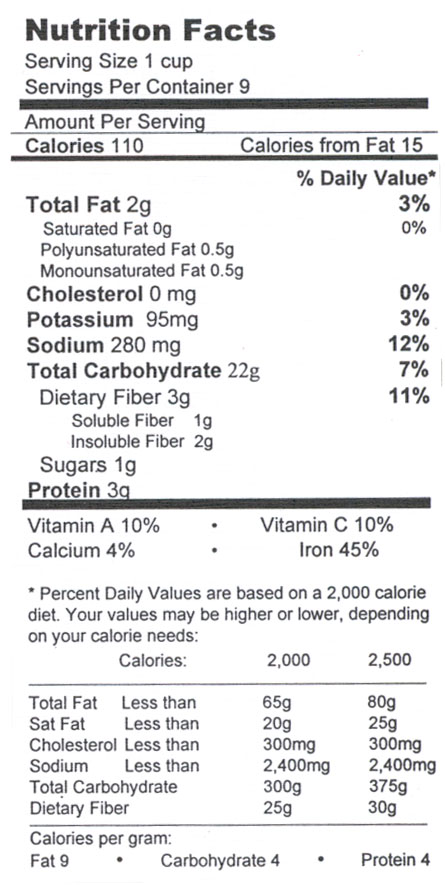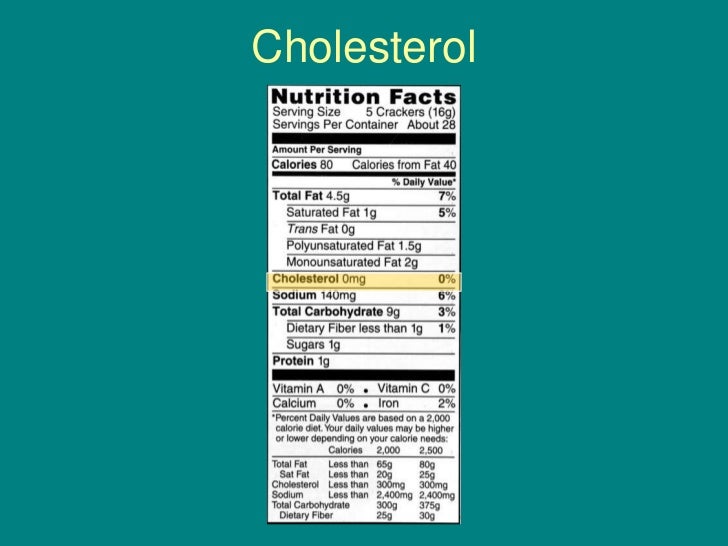39 reading food labels for cholesterol
Reading Food Labels | ADA - American Diabetes Association We'll cover the basics so that these labels make shopping easier for you. Get started. Understanding Carbs. You've heard it all. From carb-free to low-carb, to whole and empty carbs, it's hard to know what it all means. Learn more. Food & Blood Sugar. Blood sugar highs and lows aren't always easy to understand. How to Understand and Use the Nutrition Facts Label | FDA Note that Trans fat and Total Sugars do not list a %DV on the Nutrition Facts label. Protein ...
Interactive Nutrition Facts Label - Accessdata.fda.gov The Nutrition Facts label on food and beverage packages shows the amount in milligrams (mg) and the % Daily Value (%DV) of cholesterol per serving of the food.

Reading food labels for cholesterol
How to Read Food Labels for a Heart-Healthy Diet Berries: "I usually choose blueberries, which are anti-inflammatory and not as high in sugar as bananas.". Yogurt: "I choose a low-fat brand that's marketed as 'diabetes friendly' on the label, which means it's low in carbohydrates. You get all the benefit of yogurt with far fewer carbs. Food labels - NHS These labels provide information on the number of grams of fat, saturated fat, sugars and salt, and the amount of energy (in kJ and kcal) in a serving or portion of the food. But be aware that the manufacturer's idea of a portion may be different from yours. Some front-of-pack nutrition labels also provide information about reference intakes. Reading food labels: Tips if you have diabetes - Mayo Clinic Monounsaturated fats — such as olive, canola or peanut oils; nuts; and seeds — promote heart health, too. Avoid unhealthy ingredients, such as excessive salt or added sugars, saturated fats, or hydrogenated or partially hydrogenated oil. Keep in mind that ingredients are listed in descending order by weight.
Reading food labels for cholesterol. How to read food labels | healthdirect Saturated fats are linked to an increased risk of heart disease and high blood cholesterol, so it is especially important to choose foods low in saturated fat. Carbohydrate (total): Carbohydrates are found in all fruit and vegetables, all breads and grain products, and sugar and sugary foods. You need carbohydrates for energy. Click to open PDF. Understanding Food Nutrition Labels | American Heart Association 1 - Start with the serving information at the top. This will tell you the size of a single serving and the total number of servings per container (package). 2 - Next, check total calories per serving and container. Pay attention to the calories per serving and how many calories you're really consuming if you eat the whole package. PDF How Do I Understand the "Nutrition Facts" Label? • Cholesterol — is found in foods that come from animals, such as meats, poultry, seafood, eggs and full-fat dairy products. The FDA's Dietary Guidelines for Americans recommend eating as little dietary cholesterol as possible within a healthy diet pattern. • Sodium — is in food products as both naturally occurring and added sodium. Quick Tips for Reading the Nutrition Facts Label Quick Tips for Reading the Nutrition Facts Label Healthy cooking and eating start at the grocery store. Bring ... Cholesterol 0mg Sodium 160mg Total Carbohydrate 37g Dietary Fiber 4g
How to Read Food Labels : Food Network | Food Network Reading Food Labels Get the facts on saturated fats, trans fats and cholesterol. By: Joan Salge Blake, M.S., R.D., L.D.N. Since it is mandatory that both the amount of saturated fat and dietary... Food Labels: Fat & Cholesterol - HGIC@clemson.edu When comparing food labels, combine the grams (g) of saturated fat and trans fat, then choose the food with the lower combined amount. Look for the lowest % Daily Value for cholesterol, also. Ingredients List: When a food is made with more than one ingredient, an ingredients list is required on the label. Ingredients are listed in order by weight, with the greatest amount listed first and the least amount last. How to Read Food Labels Without Being Tricked - Healthline Still, processed foods that are labeled low-carb are usually still processed junk foods, similar to processed low-fat foods. Made with whole grains. The product may contain very little whole ... How to Read Nutrition Facts Labels the Right Way - GoodRx However, foods that contain less than 0.5 g per serving are allowed to list the trans fats as 0 g on a nutrition label, so consumption of these fats is still possible. Foods that may contain small amounts of trans fats include: Packaged baked goods. Ready-to-eat frozen meals. Refrigerated doughs. Fried foods. Margarine. Shortening
PDF A Guide to Reading Food Labels - University of Rochester Sample Label 1 Serving Size Calories . Limit These . Nutrients . Get Enough of These Nutrients 5 Nutrition Facts 18% 15% 10% 20% 10% 0% 4% 2% 20% 4% Serving Size 1 cup (228g) Servings Per Container 2 Amount Per Serving Calories 250 Calories from Fat 110 % Daily Value* Total Fat 12g Saturated Fat 3g Trans Fat 3g Cholesterol How to read food labels: MedlinePlus Medical Encyclopedia Whole-grain breads, fruits and vegetables, and beans and legumes are high in fiber. Check the total fat in 1 serving. Pay special attention to the amount of saturated fat in 1 serving. Choose foods that are low in saturated fat. For example, drink skim or 1% milk instead of 2% or whole milk. Skim milk has only a trace of saturated fat. How to Read the Nutrition Facts Label on Packaged Foods Limit salt to 2,300 milligrams (about 1 teaspoon) daily. If you have high blood pressure, kidney disease, or diabetes, or are African-American or older than 51, your daily limit is lower: 1,500... Reading Food Labels - Saint Luke's Health System Reading Food Labels. Look for the Nutrition Facts label on packaged foods. Reading labels is a big step toward eating healthier. The tips below help you know what to look for. ... But many foods high in cholesterol are also high in saturated fat. So it is recommended to limit saturated fat in your diet. Calories from fat.
How to Tell If Foods Are Low or High Cholesterol Dietary cholesterol is also consumed through animal products, such as dairy products, meat, fish, and egg yolks. Foods derived entirely from plants, such as vegetables, fruits, and grains, contribute insignificant, if any, amounts of cholesterol. 2. Blood cholesterol and dietary cholesterol are not the same thing.
How to Read Nutrition Labels: Fat Content, Carbs & What To Look For Total Fat. Nutrition labels are required to include total fat, saturated fat, and trans fat. The total amount of fat in the diet is a percentage of your calorie needs. The recommendation for the typical American diet is around 30%. For someone taking in 2,000 calories, this would mean around 70 grams of total fat per day.

Food labels saying cholesterol free do not necessarily mean they are good for your cholesterol ...
PDF Food Label Tip: Choose Low Saturated Fat Trans Fat and Cholesterol These food labels are for one serving of milk: 1 cup (8 ounces). Fat-free milk has the lowest % of saturated fat and cholesterol. It has 0% of the Daily Value of saturated fat and 2% cholesterol. Whole milk has 25% of the Daily Value of saturated fat and 12% cholesterol. Milk does not have trans fat. Fat-free milk is a better choice. Potato Chips
How to Read Nutrition Labels - Frederick Health Always check the back of the nutrition label to confirm that the following buzzwords are truly accurate: Fat-free Fortified or enriched Fruit-flavored Good source of Gluten-free Light Low-calorie Low-cholesterol Low-fat Multigrain Natural No added sugar Organic Reduced Zero trans fat
Reading Food Labels - What You Need to Know - Drugs.com Care guide for Reading Food Labels. Includes: possible causes, signs and symptoms, standard treatment options and means of care and support. ... "Reduced" or "less" fat: At least 25 percent less fat, when compared to a similar food. Cholesterol: "Cholesterol free": Less than two mg of cholesterol per serving. "Low cholesterol": Twenty (20) ...
How to Read Food Labels Like a Nutritionist | HUM Nutrition Blog Step 1: Be Wary of Claims. Look at food labels like you're reviewing a potential paramour's online-dating profile. In other words, be skeptical of baiting phrases. (Think terms like "cholesterol free" and "natural.") Studies have shown that consumers are more likely to buy products with health claims, but the truth is that many of ...
Reading and Understanding Food Labels and Nutrition Info A good range is between 20-60 grams; the lower number representing a 10-percent fat diet and the higher number a 30-percent fat diet. When considering the amount of fat you eat, don't forget to count meat, which doesn't have a label. A three-ounce serving of lean meat, fish or poultry can contain anywhere from three to 10 grams of fat.
Reading food labels | Heart Foundation How to read a food label · Energy (kilojoules) · Protein · Fat (total) · Saturated fat · Carbohydrate (total) · Sugars · Sodium.
Easy Guide to Understanding Food Labels When You Have High Cholesterol ... Easy Guide to Understanding Food Labels When You Have High Cholesterol Ignore the claims on the packaging. Many people base their purchase on the claims manufacturers print on their packaging. Read the nutrition information panel. When shopping for food, use the nutrition information panel to ...
Reading Food Labels -Understanding Food Label Facts, Parts of the Food Label, Eating Healthy ...
PDF How to Read the Food Label - Risk Services such as meats, poultry, fish, eggs, and dairy. Try to keep your cholesterol intake to less than 300 milligrams (mg) per day. A low-cholesterol food has less than 20 mg per serving. Sodium Too much sodium (salt) may raise your blood pressure. Less than 2,300 mg of sodium each day is recommended. A low-sodium food has 140 mg or less in one serving.
5 tips for decoding food labels - Harvard Health Look for fat: the good, the bad, and the really bad. Check the saturated fat and trans fat content of the food. For a general healthful diet, keep saturated fat and cholesterol low and avoid trans fats altogether. Look for foods that have 0 grams (g) of trans fat and are lowest in saturated fat and cholesterol.

How To Read Food Labels | Healthier Lifestyle Recipes | Reading food labels, Nutrition labels ...
Reading food labels: Tips if you have diabetes - Mayo Clinic Monounsaturated fats — such as olive, canola or peanut oils; nuts; and seeds — promote heart health, too. Avoid unhealthy ingredients, such as excessive salt or added sugars, saturated fats, or hydrogenated or partially hydrogenated oil. Keep in mind that ingredients are listed in descending order by weight.

Reading Food Label Worksheet English Esl Labels Worksheets Most Ed 18 Results in 2021 | Reading ...
Food labels - NHS These labels provide information on the number of grams of fat, saturated fat, sugars and salt, and the amount of energy (in kJ and kcal) in a serving or portion of the food. But be aware that the manufacturer's idea of a portion may be different from yours. Some front-of-pack nutrition labels also provide information about reference intakes.

Cholesterol Free Chtistmas Fare / Drug-Free Ways to Lower Your Cholesterol | Reader's Digest ...
How to Read Food Labels for a Heart-Healthy Diet Berries: "I usually choose blueberries, which are anti-inflammatory and not as high in sugar as bananas.". Yogurt: "I choose a low-fat brand that's marketed as 'diabetes friendly' on the label, which means it's low in carbohydrates. You get all the benefit of yogurt with far fewer carbs.







Post a Comment for "39 reading food labels for cholesterol"